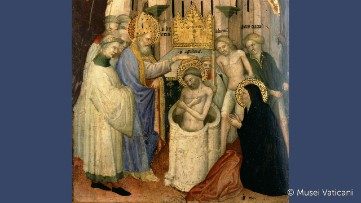St. Monica, Mother of St. Augustine, Bishop -August 27
St. Monica, Mother of St. Augustine, Bishop
Of Berber stock, Monica was born in northern Africa in 331, in the town of Thagaste, to a wealthy family with strong Christian traditions. She learned the teachings of Sacred Scripture with great devotion: prayer and assiduous practice of the sacraments forged her interiority, and she was active in the service of the Church community. She married Patricius, an ambitious, irascible pagan who was unfaithful unfaithful to her. Gentle, benevolent, and capable of finding the right moment in dialogue, with her “method” of waiting, patience and prayer - which she suggested to friends who confided in her their own problems and misunderstandings with their spouses - succeeded in winning over her husband and leading him to the faith.
Wife and mother
At the age of 22, she gave birth to her firstborn, Augustine, who was followed by Navigius, and a daughter whose name has been lost. Monica reared them in a Christian household. Widowed at 39, she was left in charge of managing the family property, dedicating herself with love to her offspring. A thoughtful and careful mother, Monica experienced great difficulty on account of Augustine, the “son of so many tears”, the restlessness of whose heart is known throughout the world. Before his conversion, Augustine was an ambitious rhetor who, in search of truth, moved away from the Catholic faith and went from one philosophy to to other. Monica never ceased praying for him, and followed all the affairs of his life in an effort to remain close to him. For this reason, she moved to Carthage and then to Italy, when her son, a professor of rhetoric, at the height of his career, went to live in Milan (then the seat of the Roman imperial government). Her motherly affection and prayers accompanied the conversion of Augustine, who, having received baptism from Bishop Ambrose, decided to return to Thagaste to found a community of God’s servants. Monica was with him. To return to Africa, it was necessary sail from Ostia. There, however, mother Monica and son Augustine were compelled to stay and await the arrival of their ship.
Ostia's ecstasy and death
Waiting to take ship at Ostia, Monica and Augustine enter into days of intense spiritual dialogue. One of these constituted the so-called vision at Ostia, narrated in the Confessions (IX.x.23-27). “she and I stood alone, leaning in a certain window, from which the garden of the house we occupied at Ostia could be seen; ... We then were conversing alone very pleasantly; and, forgetting those things which are behind, and reaching forth unto those things which are before, ... we opened wide the mouth of our heart, after those supernal streams of Your fountain, the fountain of life, which is with You; that being sprinkled with it according to our capacity, we might in some measure weigh so high a mystery. And when our conversation had arrived at that point, that the very highest pleasure of the carnal senses, and that in the very brightest material light, seemed by reason of the sweetness of that life not only not worthy of comparison, but not even of mention, we, lifting ourselves with a more ardent affection towards the Selfsame, did gradually pass through all corporeal things, and even the heaven itself, whence sun, and moon, and stars shine upon the earth; yea, we soared higher yet by inward musing, and discoursing, and admiring Your works; and we came to our own minds, and went beyond them, that we might advance as high as that region of unfailing plenty, where You feed Israel for ever with the food of truth, and where life is that Wisdom by whom all these things are made[.]” Monica felt that she had reached the pinnacle of her life and confesses to her son: “As far as I am concerned, this life now has no attractiveness for me. What I am still doing here and why I am still here, I do not know. My hopes on earth are exhausted. There was only one thing that made me want to stay here ...: to see you as a Catholic Christian before you died. My God has greatly satisfied me, for I even see you despise earthly happiness to serve Him. Why do I tarry here?” A few days later, Monica fell ill. She died at the age of 56, and her body was buried where Ostia Antica stands today, in the church of Sant'Aurea, probably an early Christian basilica with a necropolis alongside.
The relics of Saint Monica
The relics of Saint Monica have been kept for centuries in Sant'Aurea. Today there is only a tombstone, since in the 15th century Pope Martin V desired that her relics be translated to Rome, and housed in the church of San Trifone - in the care of the Augustinian Friars - and then enshrined in the larger Basilica of St. Augustine. There they remain to this day, in a sarcophagus of green marble, in the chapel decorated by Pietro Gagliardi with frescoes in 1885.


Comments
Post a Comment